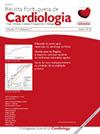Beyond clinical trials – The cost saving associated with dapagliflozin use in Portugal hospital clinical practice
IF 1.6
4区 医学
Q3 CARDIAC & CARDIOVASCULAR SYSTEMS
引用次数: 0
Abstract
Introduction and objectives
Heart failure (HF) is a clinical syndrome associated with substantial morbidity, mortality, and healthcare costs. Dapagliflozin has proven efficacy in reducing the risk of death and hospitalization in HF patients, regardless of left ventricular ejection fraction (LVEF). This paper aimed to project the potential impact of dapagliflozin on healthcare costs related to HF subsequent hospitalizations (HFHs) in Portuguese hospitals.
Methods
The total number of HF-related hospitalizations (hHF), HFHs, and the average length of stay for patients with a primary diagnosis of HF from six Portuguese hospitals, between January 2019 and December 2021, were collected and aggregated by hospital classification. Costs associated with HFHs were calculated according to Portuguese legislation and considering conservative, average, and complex approaches. Cost-saving projections were based on extrapolations from hHF risk reductions reported in dapagliflozin clinical trials.
Results
Considering a 26% risk reduction in hHF reported on pooled-analysis of DAPA-HF and DELIVER as the expected reduction in HFHs, the use of dapagliflozin would be associated with cost savings ranging from EUR 1 612 851.54 up to EUR 6 587 360.09, when considering all hospitals and the different approaches, between 2019 and 2021. A similar projection is observed based on 24% RRR derived by weighting DAPA-HF and DELIVER sub-analyses and PORTHOS epidemiological data.
Conclusions
In this projection, dapagliflozin use in all eligible hHF patients is associated with a significant reduction in direct costs. Our data support that, in addition to the improvements in HF-related outcomes, dapagliflozin may have a significant economic impact on healthcare costs in Portuguese hospitals.
临床试验之外 - 在葡萄牙医院临床实践中使用达帕格列净可节省成本。
导言和目标:心力衰竭(HF)是一种与大量发病率、死亡率和医疗成本相关的临床综合征。事实证明,无论左心室射血分数(LVEF)如何,达帕格列净都能有效降低心力衰竭患者的死亡和住院风险。本文旨在预测达帕格列净对葡萄牙医院与高血压后续住院(HFHs)相关的医疗费用的潜在影响:收集了2019年1月至2021年12月期间葡萄牙六家医院的HF相关住院总人数(hHF)、HFHs以及初诊为HF患者的平均住院时间,并按医院分类进行汇总。根据葡萄牙法律,并考虑到保守、平均和复杂方法,计算了与高频心房颤动相关的成本。成本节约预测基于达帕格列净临床试验中报告的高血压风险降低的推断:结果:如果将 DAPA-HF 和 DELIVER 的汇总分析所报告的 HFH 风险降低 26% 作为 HFHs 的预期降低率,那么考虑到所有医院和不同的方法,在 2019 年至 2021 年期间,使用达帕格列净可节约成本 1 612 851.54 欧元至 6 587 360.09 欧元不等。通过加权 DAPA-HF 和 DELIVER 子分析以及 PORTHOS 流行病学数据得出的 24% 的 RRR 也得出了类似的预测结果:在这一预测中,所有符合条件的 hHF 患者使用达帕格列净可显著降低直接费用。我们的数据证明,除了改善心房颤动相关预后外,达帕格列净还可能对葡萄牙医院的医疗成本产生重大经济影响。
本文章由计算机程序翻译,如有差异,请以英文原文为准。
求助全文
约1分钟内获得全文
求助全文
来源期刊

Revista Portuguesa De Cardiologia
CARDIAC & CARDIOVASCULAR SYSTEMS-
CiteScore
2.70
自引率
22.20%
发文量
205
审稿时长
54 days
期刊介绍:
The Portuguese Journal of Cardiology, the official journal of the Portuguese Society of Cardiology, was founded in 1982 with the aim of keeping Portuguese cardiologists informed through the publication of scientific articles on areas such as arrhythmology and electrophysiology, cardiovascular surgery, intensive care, coronary artery disease, cardiovascular imaging, hypertension, heart failure and cardiovascular prevention. The Journal is a monthly publication with high standards of quality in terms of scientific content and production. Since 1999 it has been published in English as well as Portuguese, which has widened its readership abroad. It is distributed to all members of the Portuguese Societies of Cardiology, Internal Medicine, Pneumology and Cardiothoracic Surgery, as well as to leading non-Portuguese cardiologists and to virtually all cardiology societies worldwide. It has been referred in Medline since 1987.
 求助内容:
求助内容: 应助结果提醒方式:
应助结果提醒方式:


